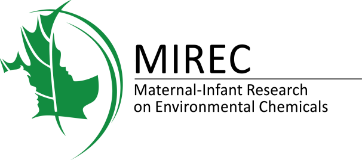
Reporting results of human biomonitoring of environmental chemicals to study participants: a comparison of approaches followed in two Canadian studies.
Haines DA, Arbuckle TE, Lye E, Legrand M, Fisher M, Langlois R, Fraser WD. Journal of Epidemiology and Community Health. 2011 Mar;65(3):191-198. doi: 10.1136/jech.2008.085597
Biomonitoring can be defined as the measurement of a chemical substance in the body’s tissues or fluids, and is used in national surveys as an indicator and measure of a population’s exposure to chemicals. There can be differences, however, in how various surveys or research studies communicate biomonitoring results to participants. This is illustrated by the MIREC Study and the Canadian Health Measures Survey (CHMS), two national population-based biomonitoring studies underway in Canada. This is due in large part to the different natures of these two studies. While MIREC recruited pregnant women from prenatal clinics, the CHMS recruited a representative sample of the Canadian population between the ages of 6 and 79 years.
The approaches used by the CHMS and MIREC to communicate individual biomonitoring results to participants were developed under the directions of their respective governing research ethics committees. Every human research study must obtain research ethics approval prior to starting the study. Research ethics committees ensure the highest ethical standards in human research. Participants in both studies were informed about whether their biomonitoring results would be communicated to them in the consent forms used in the studies. One of the key differences in the two study approaches is that the CHMS gives participants the option to receive all their biomonitoring results if they so request, but this option was not available to MIREC participants.
There are several factors to consider when comparing the respective approaches taken in different biomonitoring studies for the reporting of biomonitoring results to study participants. These include:
1) whether information on “population reference ranges” is available. This term means the range of measurement values for the general population against which the measurements taken for each individual in a study can be compared. For example, reference values can be used to identify individuals with a higher concentration of a specific environmental contaminant than those observed in the general population, and enable researchers to interpret a set of results for a particular individual.
2) health-based guidelines for which the levels of particular substances in the body’s tissues can be interpreted as being “elevated” (i.e., higher than expected or higher than normal), or linked to increased health risks or where follow-up is recommended. Health-based guidelines were available for blood levels of the metals lead, mercury and cadmium.
3) how study participants are recruited and how the study is carried out – for example, a population-based household study like the CHMS vs. the clinic-based MIREC study;
4) unique vulnerabilities of the study population – for example, pregnant women and children are regarded as vulnerable populations;
5) legislation concerning access to personal information; and
6) decisions of research ethics committees.
In the case of MIREC, the ethics committees were concerned that releasing biomonitoring results to participants, where the health significance was unknown, could result in unnecessary anxiety to the pregnant woman. In both studies, however, if any individual had a biomonitoring result that exceeded health-based guidelines, then they were notified either directly or through their physician.
MIREC Année all rights reserved - Privacy policy
Website by Riposte


